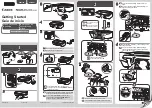
User's Guide
2-12 Set Up
Setting Communications Parameters
When the printer comes from the factory, it is ready to automatically
switch between the parallel and serial ports. To use the parallel port, no
further action is necessary. If you want to use the serial interface,
however, you may need to first set the serial communications parameters
on the printer's Setup menu. You'll need to set them so that they match
the serial protocol that your computer uses.
The serial communications parameters consist of the following:
9
9
9
9
9
INTRFCE. Lets you select the active interface: automatic switch-
ing, only parallel, or only serial.
9
9
9
9
9
BAUD. Lets you specify the serial baud rate (that is, the speed of
data transmission) that your computer uses.
9
9
9
9
9
PARITY. Lets you specify the method of parity error checking that
your computer uses.
9
9
9
9
9
DATA BITS. Lets you specify the number of data bits in each serial
data byte sent from your computer.
9
9
9
9
9
STOP BITS. Lets you specify the number of stop bits in each serial
data byte sent from your computer.
9
9
9
9
9
HNDSHK. Lets you specify the handshaking protocol (that is, the
method of printer busy notification) that your computer recognizes.
Refer to the
Control Panel
section of this guide for more information on
setting communications parameters.
User's Guide
2-12 Set Up
Setting Communications Parameters
When the printer comes from the factory, it is ready to automatically
switch between the parallel and serial ports. To use the parallel port, no
further action is necessary. If you want to use the serial interface,
however, you may need to first set the serial communications parameters
on the printer's Setup menu. You'll need to set them so that they match
the serial protocol that your computer uses.
The serial communications parameters consist of the following:
9
9
9
9
9
INTRFCE. Lets you select the active interface: automatic switch-
ing, only parallel, or only serial.
9
9
9
9
9
BAUD. Lets you specify the serial baud rate (that is, the speed of
data transmission) that your computer uses.
9
9
9
9
9
PARITY. Lets you specify the method of parity error checking that
your computer uses.
9
9
9
9
9
DATA BITS. Lets you specify the number of data bits in each serial
data byte sent from your computer.
9
9
9
9
9
STOP BITS. Lets you specify the number of stop bits in each serial
data byte sent from your computer.
9
9
9
9
9
HNDSHK. Lets you specify the handshaking protocol (that is, the
method of printer busy notification) that your computer recognizes.
Refer to the
Control Panel
section of this guide for more information on
setting communications parameters.
Summary of Contents for ACCEL-6300
Page 1: ...AMT ACCEL 6300 Document No 387002 Rev E User s Guide P R I N T E R S E R I E S ...
Page 3: ...User sGuide ii Preface ...
Page 15: ...AMTDATASOUTHCORP 4765 Calle Quetzal Camarillo CA 93012 ...
Page 23: ...User sGuide xxii Contents ...
Page 27: ......
Page 45: ......
Page 63: ......
Page 159: ......
Page 165: ......
Page 179: ......
Page 235: ......
Page 245: ......
Page 255: ......
















































